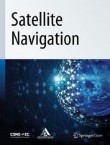Satellite Navigation is the official journal of the Aerospace Information Research Institute.
A FIR filter assisted with the predictive model and ELM integrated for UWB-based quadrotor aircraft localization
To improve the accuracy of the Ultra-Wide Band (UWB) based quadrotor aircraft localization, a Finite Impulse Response (FIR) filter aided with an integration of the predictive model and Extreme Learning Machine...

